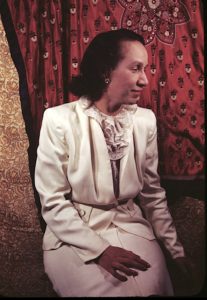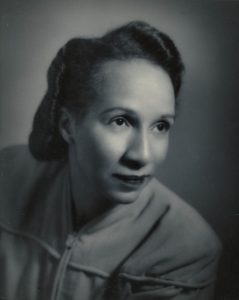Shirley Graham Du Bois: Remembering the Revolutionary Composer and Activist
Words by Kyle Long
Indianapolis’ Shirley Graham Du Bois was a true renaissance woman. Graham Du Bois left a lasting impact in several fields of endeavor, but for the purposes of this article, we’ll focus on her achievements in music – some of which happened right here in her hometown.

When Shirley Graham Du Bois died on March 27 of 1977, obituaries appeared in newspapers around the world. In these remembrances, Graham Du Bois’ status as the widow of famed civil rights leader W. E. B. Du Bois was highlighted, along with her work as an activist, novelist, and playwright. But in all the articles I’ve read that were published in the wake of Graham Du Bois’ death, no mention is made of her work in music – a strange omission, considering it was music that first made Graham Du Bois a figure of international interest.
In June of 1932, Graham Du Bois received global acclaim for her opera Tom-Tom, the first opera composed by a Black woman to be staged by a major opera company. It’s been estimated that over 25,000 spectators attended the opera during its two night run at Cleveland, Ohio’s Municipal stadium.
As news of Tom-Tom’s success circulated, there was talk of touring the opera in Europe, and staging a special performance at New York’s Madison Square Garden. But sadly, these plans never came to fruition, and Tom-Tom’s Cleveland premiere would also be the opera’s swan song. As Tom-Tom slowly faded from the public’s memory, so too did Graham Du Bois’ ambitions as a composer. By the late 1940s, Graham Du Bois had almost fully divorced herself from the world of professional music.
Graham Du Bois’ rise to international fame stands in stark contrast to her humble Hoosier roots. She was born in Indianapolis, Indiana on November 11, 1896. Her father, Reverend David A. Graham, was pastor of Indianapolis’ Bethel A.M.E. Church, located at 414 West Vermont Street. Bethel A.M.E. was home to a robust music ministry, and Graham Du Bois’ early life was filled with song and theatrical ritual.
Due to the itinerant nature of her father’s work as a pastor, Graham Du Bois left Indiana as a child. Travel was a constant during Graham Du Bois’ early years, as her father pursued opportunities from state to state. Movement would become a pattern throughout Graham Du Bois’ life, leading her to multiple career paths, on multiple continents.
 Even Graham Du Bois’ musical education reflected this flux, as she spent time studying at an array of institutions, including Columbia University, Howard University, the Institute of Musical Arts in New York City, and the Sorbonne in France. But it was during her time as a student at Ohio’s Oberlin University that Graham Du Bois received the biggest opportunity of her musical career: the production of her magnum opus Tom-Tom.
Even Graham Du Bois’ musical education reflected this flux, as she spent time studying at an array of institutions, including Columbia University, Howard University, the Institute of Musical Arts in New York City, and the Sorbonne in France. But it was during her time as a student at Ohio’s Oberlin University that Graham Du Bois received the biggest opportunity of her musical career: the production of her magnum opus Tom-Tom.
The exact details of how this opportunity came to pass are unclear, but during the early 1930s, a group of ambitious promoters in Cleveland, devised a plan to create the greatest spectacle in the history of American opera. They secured the use of Cleveland’s newly-constructed Municipal Stadium, a massive facility with the potential to hold 78,000 spectators. Launched in 1931, their endeavor was billed as Stadium Opera, and the project survived two seasons before facing financial insolvency.
Tom-Tom debuted during the second season of Stadium Opera, appearing alongside heavyweight classics including Aida, Carmen, and Die Walküre. At this point, you may be asking why a group of veteran opera promoters would gamble on premiering a new work from a relatively unknown composer like Graham Du Bois? Perhaps they sensed the history-making dynamics of presenting an operatic work by a Black woman. If that’s true, their instincts were correct, and Graham Du Bois provided Stadium Opera with an epic program that matched the grandiose scale of Verdi and Wagner.
Graham Du Bois wrote the libretto and score for Tom-Tom. The opera takes its name from the tom-tom drum. “To me, African life and music has been symbolized by the tom-tom,” Graham Du Bois wrote in a 1932 article published by The Black Dispatch newspaper. In Tom-Tom, Graham Du Bois sought to tell the history of Black music in America, from its origins in Africa, to the jazz clubs of Harlem. “It shows the Negro in slavery and carries him down to the present day, always with the notes of the tom-tom underlying his life,” Graham Du Bois explained in The Black Dispatch.
No expense was spared in the production, which featured a cast exceeding 1,000 participants – including baritone vocalist Jules Bledsoe, best known as the original voice of “Ol’ Man River” in Jerome Kern’s Showboat. “I’m the happiest girl of my race,” Graham Du Bois wrote, again from The Black Dispatch, commenting that it was her childhood dream to see “an opera by a Negro and with an all-Negro cast, telling the story of Africans and tracing their life and music.”
Graham Du Bois would never again have the opportunity to create a musical work on such a massive scale, but she did continue developing concepts that mixed classical European forms with African-American expressive arts.
After graduating from Oberlin, Graham Du Bois took a position as director of the Chicago Negro Unit of the Federal Theatre Project – an arts-based branch of President Franklin D. Roosevelt’s Works Progress Administration. During her time with the Federal Theatre Project, Graham Du Bois produced The Swing Mikado, a jazz age interpretation of the famous Gilbert and Sullivan comic opera The Mikado. The Swing Mikado made national news, and after a five-month run in Chicago, the show was featured on the Broadway stage.
When the Federal Theatre Project ended in 1939, Graham Du Bois returned to her hometown of Indianapolis. In 1940, she took a position as director of adult activities at the newly-opened Phyllis Wheatley Y.W.C.A., formerly located at 1202 North West Street, adjacent to the Indiana Avenue neighborhood.
During her time in Indianapolis, Graham Du Bois continued producing jazz interpretations of Gilbert and Sullivan operas, including The Pirates of Penzance in 1940, and H.M.S. Pinafore in 1941. Graham Du Bois’ staging of The Pirates of Penzance received significant notoriety in Indianapolis, premiering at B.F. Keith’s, one of the leading vaudeville theaters in the city. There was also a special performance at Crispus Attucks, an all-Black high school established in Indianapolis during the era of segregation.
Graham Du Bois spent roughly two years working in Indianapolis before taking a national position with the Y.W.C.A. in late 1941. Graham Du Bois’ time in Indianapolis represents her last significant involvement in the world of professional music. Graham Du Bois turned to writing as her primary creative outlet. She published several titles during the 1940s, including her award-winning 1947 biography There Once Was A Slave: The Heroic Story of Frederick Douglass.
By the time Graham Du Bois married W. E. B. Du Bois in 1951, her work had become explicitly political. Like her husband, Graham Du Bois had voiced her support for the Communist Party of the U.S.A. As the Red Scare of the late 1940s led to McCarthyism, the couple felt the brunt of anti-communist sentiment in America. Shortly after their marriage, W. E. B. Du Bois was indicted by the House Un-American Activities Committee. The couple’s tireless advocacy for civil rights also brought them under tremendous pressure.
 In 1961, the Du Boises made the decision to leave the United States, taking up residence in Ghana at the invitation of Kwame Nkrumah. Graham Du Bois would spend the rest of her life residing outside of the United States, with extended stays in Tanzania, Egypt, and China. Graham Du Bois died in Beijing, China on March 27, 1977. She was 80 years old.
In 1961, the Du Boises made the decision to leave the United States, taking up residence in Ghana at the invitation of Kwame Nkrumah. Graham Du Bois would spend the rest of her life residing outside of the United States, with extended stays in Tanzania, Egypt, and China. Graham Du Bois died in Beijing, China on March 27, 1977. She was 80 years old.
While Graham Du Bois’ work in music has often been overshadowed by her accomplishments as a writer and activist – that’s starting to change. The recent discovery of a partial score for Tom-Tom in Harvard’s Schlesinger Library has stirred up talk of a revival (the original orchestral score is considered lost). Regardless of Tom-Tom’s future, Graham Du Bois deserves greater recognition for her groundbreaking contributions to American music, and her remarkable ability to overcome the painful legacy of misogyny and racism in early 20th Century America.
“We are a dramatic people. Our situation in this country is dramatic,” Graham Du Bois told the Indianapolis Times in July of 1940. “They say the Negro laughs a lot, but much of the time we laugh to keep from crying.”







Leave a Reply